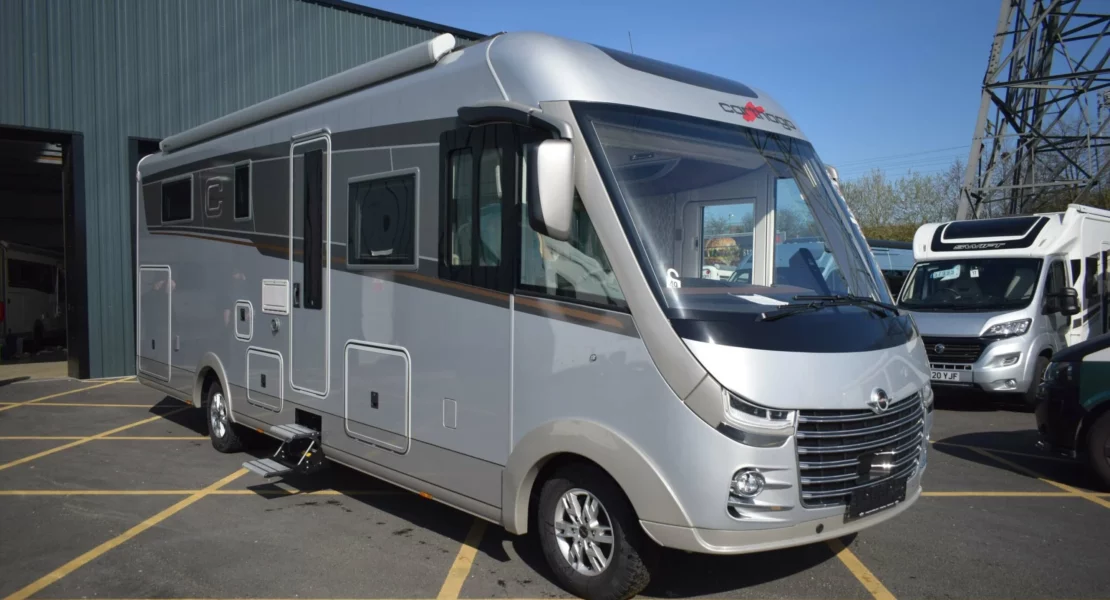
Coachbuilt vs A-Class Motorhomes Comparison
Contents
- Different types of considerations
- Coachbuilt Motorhomes
- Regular coachbuilt
- Overcab coachbuilt
- Low-profile coachbuilt
- A-Class motorhomes
Coachbuilt vs A-Class Motorhomes Comparison
The scenario is: You march into your favourite dealership, hand over a wedge of cash and point vaguely towards a motorhome that looks like it will do a job for you. But that approach really won’t benefit you – or, at least, the chances of hitting ‘bullseye’ are pretty variable! It always pays to do a bit of research, and consider the information you find. You should try and balance your needs and wants with what is on offer – and taking a little more time in this way will mean that ‘bullseye’ is more likely. Getting ‘the one’ when you’re choosing a new leisure vehicle is probably not always quite as simple as you think.
Different types of considerations
For a start, you’ll want to mull over the various possible options to do with things such as the size of the engine, the facilities, fixtures and fittings included (e.g. kitchen and bathroom), the number of beds (berths) and the total living space afforded by the interior layout, as well as balancing everything against the constraints or elasticity of your budget. You’ll perhaps find yourself in the position of considering whether to maximise that budget by opting for a pre-owned vehicle. Doing so will gain you immediate access to a better level of vehicle with greater features and specifications than you would have been able to afford if you were buying from brand new.
You’ll also find that you have a choice to make between Coachbuilt and A-Class. Here at Go European, we are specialists in A-Class motorhomes, offering some stunning vehicles including the Carthago range. If you don’t know what the difference between A-Class and Coachbuilt means, then this edition of our blog is the one for you! We’ll briefly explain the difference between these two types of motorhome, as it’s important to understand.
In truth, there is the possibility that this aspect of motorhomes might not be the determining factor for you. There is likely to be a motorhome which ticks all the boxes, meets all of your requirements and also seems to have that extra ‘something’ you are looking for – a special feature, a particular layout or even just ‘a vibe’, and the fact it is one or the other (Coachbuilt or A-Class) is neither here nor there to you. It’s not a deal-breaker. However, for some people it’s important. Why is that?
Coachbuilt Motorhomes
Coachbuilt describes a method of building. It means that the motorhome manufacturer has used a pre-existing cab and chassis and literally built onto that. The front aspect of the van will look like the front of the pre-existing vehicle which has been built upon.
Regular coachbuilt
Coachbuilt motorhomes tend to be wider and taller, so that means extra space in the interior, which is very useful and desirable if you are going to use the vehicle to be out in the vehicle for extended periods. You can live very comfortably in a coachbuilt, and the interior will have just about everything you need for day-to-day living. There will be comfortable seats, social space, storage, sleeping areas – plus those all-important cooking and washing facilities. The coachbuilt class contains two types.
Overcab coachbuilt
An over-cab coachbuilt motorhome is usually around 11 feet tall and with a length of approximately 20 feet. This class of coachbuilt can handle touring parties of between two and six people, as there is additional sleeping room in the section just over the driving cab (hence the term ‘over-cab’). This space can also be used, of course, for storage.
Low-profile coachbuilt
A ’low-profile’ coachbuilt motorhome will be around nine feet in height and around 28 feet long. These dimension mean it will handle a little bit better than an over-cab. There will be more storage options within the interior to compensate for the loss of storage capacity over the cab itself. Couples and smaller families will find low-profile coachbuilts to be great vehicles for their breaks and holidays. Another huge benefit is that due to their weight and size they can be driven right off the forecourt on a Cat. B UK standard car driving licence – so there’s no issue with further testing required.
A-Class motorhomes
The big difference between Coachbuilt and A-Class is that the driver’s area (the cab) in an A-Class is contained within the main body of the vehicle. A-Class motorhomes are constructed from the chassis upwards, with the whole thing being built as one single unit (rather than the living area being put onto the rear of a pre-existing cab). In an A-Class motorhome, the driver’s cab spans the width of the vehicle – and both of the seats can be turned to face into the living space as well as facing forwards. A-Class motorhomes also contain a much larger windscreen than coachbuilt, which offers great road visibility or, when parked up, great views of the scenery.
A-Class motorhomes average at around 13 feet tall and 30 feet long, so they are a lot larger than coachbuilt motorhomes, and therefore there is an expense issue. They can be quite a bit more expensive, but the extra space is of great appeal to those who have larger families. Because they are larger, and therefore heavier, the driver will need to be licensed to drive 3.5 tonne plus.
Here at Go European, we have a fantastic selection of top quality vehicles for you to choose from – including, as we mentioned earlier, the stunning Carthago range of A-Class motorhomes. You can find out more by browsing our website or, if you would prefer to speak to someone in person, please don’t hesitate to contact us and we will do our best to answer every one of your queries. Happy motoring!